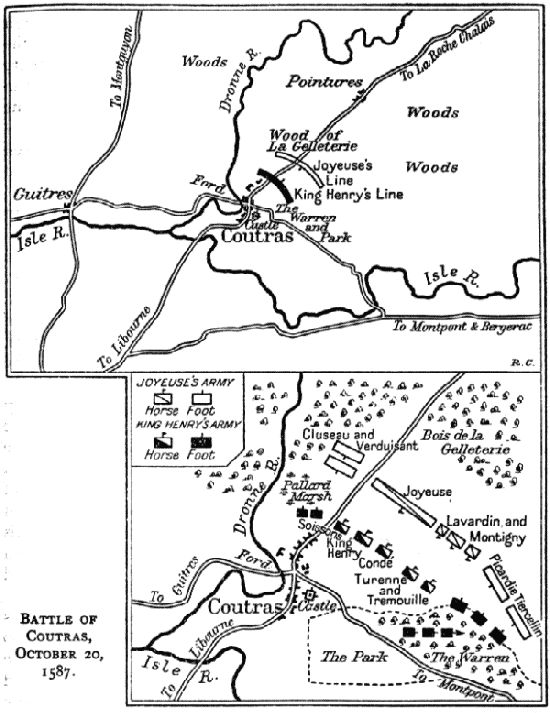Date 20 October 1587 | Result Decisive Huguenot victory | |
 | ||
5,000 infantry1,800 cavalry 5,000 infantry1,800 cavalry 40 killed 2,000 men, of which300 nobility Similar French Wars of Religion, Battle of Arques, Battle of Moncontour, Battle of Jarnac, Battle of Saint‑Denis | ||
Battle of coutras
The Battle of Coutras, fought on 20 October 1587, was a major engagement in the French Religious Wars between a Huguenot (Protestant) army under Henry of Navarre (the future Henry IV of France) and a royalist army led by Anne, Duke of Joyeuse. Henry of Navarre was victorious, Joyeuse was killed while attempting to surrender.
Contents
Context
The Wars of Religion between the Catholics and Protestants in France had begun in 1562 and continued intermittently since, with temporary periods of nominal peace that were often also violent. The King of France Henry III conducted a conciliatory policy, as reflected in the enactment of the Edict of Beaulieu in 1576 and the Edict of Poitiers the following year. But a new crisis arose as the result of the death of the king's brother, Francis of Alençon, when the Huguenot, Henry of Navarre, became heir presumptive to the throne. The League, led by the Duke of Guise, then set the kingdom against the king, who became isolated.
On 18 July 1585, Henry III promulgated an edict canceling all previous edicts, giving precedence "to the Catholics", paying the mercenaries of the League of the Royal Treasury, prohibiting Protestantism in France, and ordering the return of safe Protestant strongholds. Protestants were expelled from power. And while the Guise party won appointments and favours, the king of Navarre was deprived of his functions.
This edict was effectively a declaration of war against the Protestants. Henry of Navarre sought support, initially without success. The "private bull" (bulle privatoire) by Pope Sixtus V brought him a measure of support from French royalists and Gallican circles; joined by the Politiques français, supporters of religious tolerance (such as the Governor of Languedoc, Montmorency-Damville) and later England and Denmark, but only after the assassination of William of Orange, the deposition of the Elector of Cologne (the bishop became Calvinist), and the success of Spain in its fight against the Protestants of the Netherlands.
Faced with the intransigence of Guise, war was inevitable. Joyeuse was sent south with an army, while Mercoeur invaded Poitou and blocked Condé at La Rochelle.
Battle
The clash of the two cavalry forces was to the advantage of the King of Navarre. The Duke of Joyeuse launched a charge at full gallop; by the time they came into contact, his horses were exhausted, and his squadrons of lancers had lost cohesion, rendering them ineffective. For his part, Henry of Navarre adopted an innovative tactic in the disposition of his troops: he inserted the platoons of musketeers (five men abreast) within cavalry squadrons, to improve their support. The charge of light cavalry Protestants broke the Royalist army, which was routed. The Duke of Joyeuse was defeated, captured and killed by a pistol shot. 2,000 Catholics were also captured along with Anne's younger brother, Claude Joyeuse (1569-1587), lord of Saint-Sauveur and Jacques d'Amboise, the eldest of the branch of Amboise-d'Aubijoux.
Victory went to the Protestants, led by Henry of Navarre. He recovered the body of Joyeuse and attended a mass in honour of his slain enemies.
